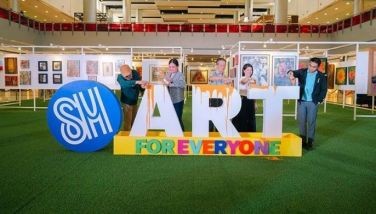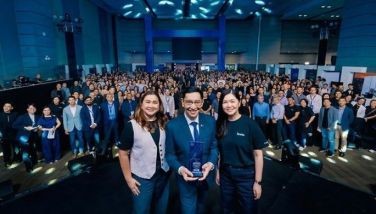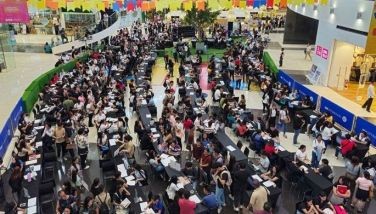Retracing my musical roots
MANILA, Philippines - Ateneo De Manila University (ADMU) has always been very supportive of the arts. Every year, countless events are mounted by the university to promote arts and culture both in and out of campus. From the performance arts to exhibits, book launches, poetry readings, film viewings, ADMU makes it a point to venerate its artists and their victories.
Established in 1992, Awit Nasyonalista is a songwriting contest that fosters not just the ability to write and perform songs, but to analyze and critique as well. It puts a premium on substance, not just on how it is said but what is said, which stimulates creativity and analytical thinking as well. It is a celebration of Ateneo’s love affair with music that started somewhere between instilling Magis (Jesuit ideal, doing ordinary things extraordinarily well) and the formation of organizations like the Ateneo Children’s Theater, Ateneo Boys Choir and Dulaang Sibol, to name a few. These organizations, along with contests and competitions and of course, Magis, created the perfect climate for artists such as Basil Valdez, APO Hiking Society, The Itchyworms, Karylle, Miguel Escueta, Kjwan, Parokya ni Edgar and Chicosci to develop.
Back in 1999, when I was a highschool sophomore, I represented my section with a song I wrote called Agos (which would later reincarnate as our song Makapiling Ka). For the performance, everyone wanted to join so anyone who could play anything, from broken pieces of wood to a jar full of coins, joined the presentation. The endeavor helped improve solidarity as well as our grades in Araling Panlipunan (God bless bonus points).
From our batch, the first place winner was Chris Cantada, our former drummer turned solo artist. The second place winner was Ian Millare formerly of the Akafellas and Los Magno of hiphop group Out of Body Special and our class won third place with a little help from our bassist Gosh Dilay. Given the results, I think it’s safe to assume that Awit Nasyonalista took that tiny spark called interest and turned it into overwhelming fire. Thirteen years later, I’m still passionate about writing songs, and here I am judging Awit Nasyonalista for the first time.
I was surprised to see how things were so relaxed as I sat next to fellow judges Fr. RB Hizon and Ms. Jo Lechoncito in Hayes Hall (a.k.a Bulwagang Hayes). Each class had one minute to set up props, visuals and instruments. Hosts Glen Teh and Drew Elepano of the Araling Panlipunan department were making fun of the contestants, but that didn’t rattle them one bit. Back then, we had that same window of time, but I remember panicking a lot more. The stakes were much higher for a contestant back then and the possibility of disqualification seemed so daunting given the amount of work we had already put in.
With the presentations underway, I noticed that while there were more rock bands in today’s Awit Nasyonalista, the templates of groups were still pretty similar. Aside from the traditional rock band setup of guitars, bass and drums, there’s also that choir-based group that would have one, sometimes two guitarists. There were also a bunch of groups that used smile-inducing happy major seventh chords, reminiscent of feel good TV station IDs. Of course, there is still the “slacker group” that would come up with something unorthodox yet funny and memorably astig in their own catchy, deviant way.
 That’s me with the participants of ADMU’s Awit Nasyonalista songwriting contest
That’s me with the participants of ADMU’s Awit Nasyonalista songwriting contest Another new element would have to be the incorporation of the laptop and digital synths in the performances. Back then, I think Richie Rich was the only one with a laptop. Today, kids don’t even know who Richie Rich is but everyone sure has a laptop and they even use it as musical instruments these days since it can produce or replicate anything you want.
In terms of arrangement, the kids of today are more daring with their musical twists and turns. Groups hardly used the standard verse-chorus-verse-chorus-bridge-chorus arrangement. Instead, most groups made elaborate, complex bridges, codas and a whole lot more. Even instrumentation was more colorful as some groups had saxophones, violins, kahons and flutes. Clearly, this generation drew inspiration from everything they could grab a hold of, and given today’s technology, they were able to grab a hold of a lot. Some groups went as far as incorporating bits and pieces of musical theater, ’90s rap metal and even dreary shoegaze into their songs.
Visually, they made well-lit intricate dance and theatrical routines to supplement the musical production, to make the songs more compelling. They even made videos to make the performances more engaging and some even made full use of the theater, breaking the fourth wall for a more personal experience. I even got a high five.
I’m happy to know that the Ateneo legacy is still very much alive. Parents are always worried that kids spend way too much time going online and not doing anything productive. Looks like they learned so much from watching things online and incorporating them into their craft. After all, you become better at something by watching, learning. I’m glad these kids were able to keep the flame alive for them to pass on for more generations to come and hopefully, perhaps with the help of the same technology, from which they learned, share them for all of us to enjoy.
For a quick peek at everything that happened during Awit Nasyonalista, go to http://www.youtube.com/spongecolamusic.
For my band Sponge Cola’s schedule, check out http://facebook.com/spongecola. Catch us at SM Mall of Asia Complex tomorrow, Abreeza Mall in Davao on Mar. 17, Mall of Asia on Mar. 23, Saguijo on Mar. 26, Star Mall in San Jose, Bulacan on Mar. 31.
- Latest
- Trending






























